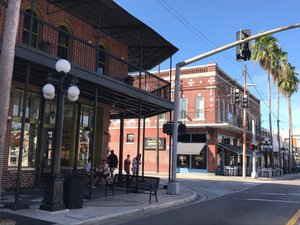Advertisement
Published: June 26th 2019

 Tampa's Ybor City
Tampa's Ybor City
Tampa's Ybor City. Seventh Avenue at 19th Street. Wrought iron balconies were a feature of many newly built Ybor City brick buildings of the 1920s, reflecting styles found in Cuba and Spain.
IMG_6406Ybor City is the old cigar making neighborhood of Tampa. In recent years Ybor City has undergone a revitalization and is a destination to enjoy the cuisines of the immigrants who worked here and roam the old buildings that made it a community. People from Cuba, Italy and Spain came here to find work in the cigar factories.
Our exploration of Ybor City began with dinner on Sunday evening at the Columbia Restaurant. The restaurant, a fixture in Ybor City, was founded it in 1905 as a corner bar and coffee shop and expanded by the 1930s into the present-day establishment. The distinctive exterior of Columbia Restaurant is covered in colorful tiles. It features Cuban cuisine, and so our introduction to Cuba began. I enjoyed the Boliche Criollo (roasted beef stuffed with chorizo).
Monday morning we returned to Ybor City. All was quiet now. On our after dinner drive around the area the previous evening, there was great activity, with people enjoying the many bars, restaurants and club along 7th Avenue. I had a list of Ybor City buildings on the National Register of Historic Places to see. They center around José Martí Park on the western end of

 Ybor Factory Complex
Ybor Factory Complex
Ybor Factory Complex. Operated as: Ybor-Manrara Cigar Factory (1886-1899); American Cigar Company (1901-1954); Hav-A-Tampa (1955-1972). "The significance of the cigar industry to Tampa and Ybor City can be illustrated by no building better than the red brick Ybor Factory Complex, which occupies almost the entire block between 8th and 9th Avenues and 13th and 14th Streets. The interconnected complex, the oldest in Ybor City, consists of two 3-story factories and a 2-story warehouse".
DSC_0652Ybor City. Several of the historic buildings, including the park itself, were undergoing renovation. But there was much to see on our walk around the vicinity.
Central to Ybor City is the Ybor Factory Complex. The cigar factory operated as: Ybor-Manrara Cigar Factory (1886-1899); American Cigar Company (1901-1954); and Hava-A-Tampa (1955-1972). (Today, it is the Church of Scientology headquarters in Tampa.) Cigar making was brought to Tampa by Vicente Martinez Ybor in 1885. He had been in the cigar business in Cuba and moved operations to Key West, Florida, in 1869 during the Ten Years War of Cuban independence. By 1885 he had relocated his business again, to Tampa. Other cigar manufacturers followed suit and Ybor City became a home for Cuban, Italian and Spanish immigrants in the South. The presence of these immigrants can by seen by the long-established social clubs that serve as centers of their communities. We saw the L'Unione Italiana (the Italian club) and El Circulo Cubano (the Cuban club). Both are housed in imposing buildings opened in 1918 and 1917, respectively. In front of the Cuban club is a bust of José Martí. A plaque commemorating Martí's 1893 address on Cuban independence to the

 Entrance to the Ybor Factory Complex
Entrance to the Ybor Factory Complex
Entrance to the Ybor Factory Complex. Operated as: Ybor-Manrara Cigar Factory (1886-1899); American Cigar Company (1901-1954); Hav-A-Tampa (1955-1972).
DSC_0658Cuban cigar workers appears in front of the cigar factory building.
After taking in more of Ybor City, we went back to the Columbia Restaurant gift shop to do some pre-cruise shopping. They have great array of ceramics, coffee, kitchen accessories and cigars for the visitor or as gifts.
Ybor City is connected to Channelside, the port area of Tampa, and downtown Tampa by TECO Line streetcars (trams).
Advertisement
Tot: 0.063s; Tpl: 0.013s; cc: 12; qc: 30; dbt: 0.0338s; 1; m:domysql w:travelblog (10.17.0.13); sld: 1;
; mem: 1.1mb

 Tampa's Ybor City
Tampa's Ybor City
 Ybor Factory Complex
Ybor Factory Complex
 Entrance to the Ybor Factory Complex
Entrance to the Ybor Factory Complex






























